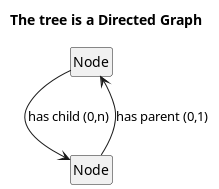Go: 1.18
Provides a basic but flexible hierarchical tree data structure together with an implementation of a Visitor pattern for tree manipulation.
import "github.com/chippyash/go-hierarchy-tree/tree"
- clone repository
- cd to project directory
go get ./...
import "github.com/chippyash/go-hierarchy-tree/tree"
//node with no value or children
node := tree.NewNode(nil, nil)
//node with some value
node := tree.NewNode("foo", nil)
//node with children
child1 := tree.NewNode("bar", nil)
child2 := tree.NewNode("baz", nil)
children := []tree.NodeIFace{child1, child2}
node := tree.NewNode("foo", &children)A node can have any value. The value of a node is an interface{}
val := tree.NewNode(nil, nil).
SetValue("foo").
GetValue()You can add children when you construct a node (see above) or afterwards.
child1 := tree.NewNode(1, nil)
child2 := tree.NewNode(2, nil)
children := []tree.NodeIFace{child1, child2}
childNodes := tree.NewNode(0, nil).
SetChildren(children...).
GetChildren()
childNodes = tree.NewNode(0, nil).
AddChild(child1).
AddChild(child2).
GetChildren()node.RemoveChild(child1)
node.RemoveAllChildren()node.IsLeaf() //true if node has no children
node.IsRoot() //true if node is the root node, i.e. no parent
node.IsChild() //true if node has a parentnode.SetParent(someOtherNode) //set the parent to the node
node.GetParent() //return parent of this node - nil if node is root
node.GetSiblings() //returns nodes with same parent
node.GetSiblingsAndSelf() //returns nodes with same parent including self
node.GetAncestors() //parents and grandparents
node.GetAncestorsAndSelf() //self, parents and grandparentsThe tree implements the Visitor pattern Accept method.
/**
* root
* /|\
* a b c
* /| |
* d e f
*/
visitor := tree.NewPreOrderVisitor()
result := root.Accept(visitor)
//returns []tree.NodeIFace{root, a, d, e, b, f, c}/**
* root
* /|\
* a b c
* /| |
* d e f
*/
visitor := tree.NewPostOrderVisitor()
result := root.Accept(visitor)
//returns []tree.NodeIFace{d, e, a, f, b, c, root}/**
* root
* /|\
* a b c
* /| |
* d e f
*/
visitor := tree.NewLeafVisitor()
result := root.Accept(visitor)
//returns []tree.NodeIFace{d, e, f, c}/**
* root
* /|\
* a b c
* /| |
* d e f
*/
visitor := tree.NewFilterVisitor(func(n tree.NodeIFace) bool {
return n.GetValue() == "e"
})
result := root.Accept(visitor)
//returns []tree.NodeIFace{e}see Filter Test for other examples
node.GetDepth() //returns the distance from the current node to the root
node.GetHeight() //returns the height of the tree whose root is this node
node.GetSize() //returns the number of nodes in the tree rooted at this nodego test ./...
- Update the readme if necessary
